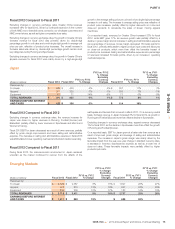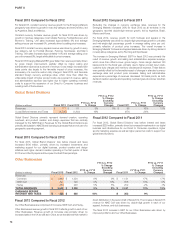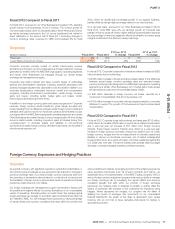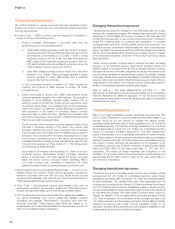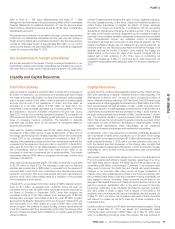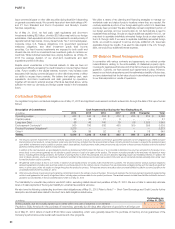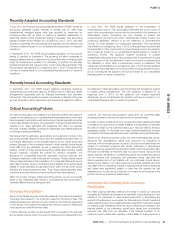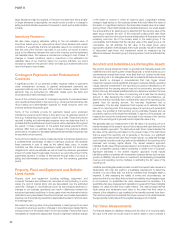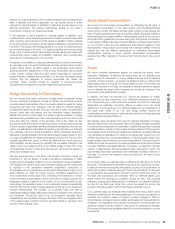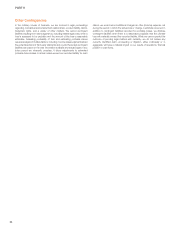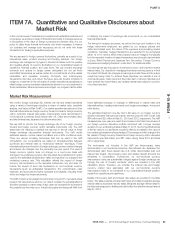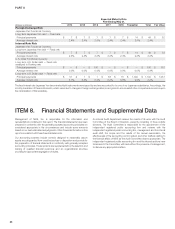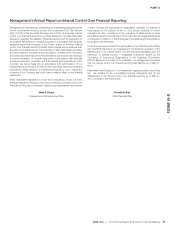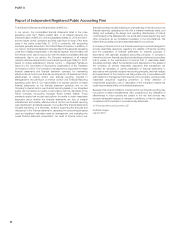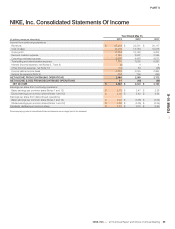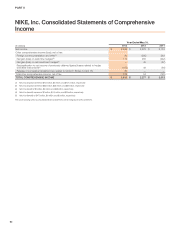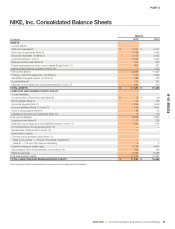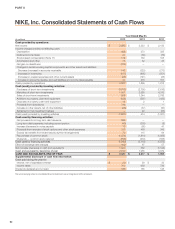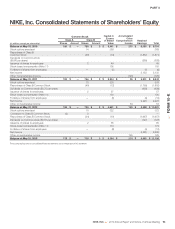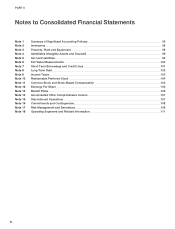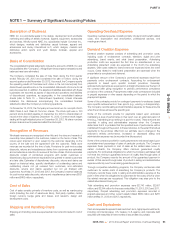Nike 2013 Annual Report Download - page 40
Download and view the complete annual report
Please find page 40 of the 2013 Nike annual report below. You can navigate through the pages in the report by either clicking on the pages listed below, or by using the keyword search tool below to find specific information within the annual report.
PART II
ITEM 7A. Quantitative and Qualitative Disclosures about
Market Risk
In the normal course of business and consistent with established policies and
procedures, we employ a variety of financial instruments to manage exposure
to fluctuations in the value of foreign currencies and interest rates. It is our
policy to utilize these financial instruments only where necessary to finance
our business and manage such exposures; we do not enter into these
transactions for trading or speculative purposes.
We are exposed to foreign currency fluctuations, primarily as a result of our
international sales, product sourcing and funding activities. Our foreign
exchange risk management program is intended to lessen both the positive
and negative effects of currency fluctuations on our consolidated results of
operations, financial position and cash flows. We use forward exchange
contracts and options to hedge certain anticipated but not yet firmly
committed transactions as well as certain firm commitments and the related
receivables and payables, including third-party and intercompany
transactions. We have, and may in the future, also use forward contracts to
hedge our investment in the net assets of certain international subsidiaries to
offset foreign currency translation adjustments related to our net investment in
those subsidiaries. Where exposures are hedged, our program has the effect
of delaying the impact of exchange rate movements on our consolidated
financial statements.
The timing for hedging exposures, as well as the type and duration of the
hedge instruments employed, are guided by our hedging policies and
determined based upon the nature of the exposure and prevailing market
conditions. Generally, hedged transactions are expected to be recognized
within 12 to 18 months. When intercompany loans are hedged, it is typically
for their expected duration. Hedged transactions are principally denominated
in Euros, British Pounds and Japanese Yen. See section “Foreign Currency
Exposures and Hedging Practices” under Item 7 for additional detail.
Our earnings are also exposed to movements in short- and long-term market
interest rates. Our objective in managing this interest rate exposure is to limit
the impact of interest rate changes on earnings and cash flows and to reduce
overall borrowing costs. To achieve these objectives, we maintain a mix of
commercial paper, bank loans and fixed rate debt of varying maturities and
have entered into receive-fixed, pay-variable interest rate swaps for a portion
of our fixed rate debt.
Market Risk Measurement
We monitor foreign exchange risk, interest rate risk and related derivatives
using a variety of techniques including a review of market value, sensitivity
analysis, and Value-at-Risk (“VaR”). Our market-sensitive derivative and other
financial instruments are foreign currency forward contracts, foreign currency
option contracts, interest rate swaps, intercompany loans denominated in
non-functional currencies, fixed interest rate U.S. Dollar denominated debt,
and fixed interest rate Japanese Yen denominated debt.
We use VaR to monitor the foreign exchange risk of our foreign currency
forward and foreign currency option derivative instruments only. The VaR
determines the maximum potential one-day loss in the fair value of these
foreign exchange rate-sensitive financial instruments. The VaR model
estimates assume normal market conditions and a 95% confidence level.
There are various modeling techniques that can be used in the VaR
computation. Our computations are based on interrelationships between
currencies and interest rates (a “variance/co-variance” technique). These
interrelationships are a function of foreign exchange currency market changes
and interest rate changes over the preceding one year period. The value of
foreign currency options does not change on a one-to-one basis with
changes in the underlying currency rate. We adjust the potential loss in option
value for the estimated sensitivity (the “delta” and “gamma”) to changes in the
underlying currency rate. This calculation reflects the impact of foreign
currency rate fluctuations on the derivative instruments only and does not
include the impact of such rate fluctuations on non-functional currency
transactions (such as anticipated transactions, firm commitments, cash
balances, and accounts and loans receivable and payable), including those
which are hedged by these instruments.
The VaR model is a risk analysis tool and does not purport to represent actual
losses in fair value that we will incur nor does it consider the potential effect of
favorable changes in market rates. It also does not represent the full extent of
the possible loss that may occur. Actual future gains and losses will differ from
those estimated because of changes or differences in market rates and
interrelationships, hedging instruments and hedge percentages, timing and
other factors.
The estimated maximum one-day loss in fair value on our foreign currency
sensitive derivative financial instruments, derived using the VaR model, was
$34 million and $21 million at May 31, 2013 and 2012, respectively. The VaR
increased year-over-year as a result of an increase in the total notional value of
our foreign currency derivative portfolio combined with a longer average
duration on our outstanding trades at May 31, 2013. Such a hypothetical loss
in the fair value of our derivatives would be offset by increases in the value of
the underlying transactions being hedged. The average monthly change in the
fair values of foreign currency forward and foreign currency option derivative
instruments was $49 million and $87 million during fiscal 2013 and fiscal
2012, respectively.
The instruments not included in the VaR are intercompany loans
denominated in non-functional currencies, fixed interest rate Japanese Yen
denominated debt, fixed interest rate U.S. Dollar denominated debt and
interest rate swaps. Intercompany loans and related interest amounts are
eliminated in consolidation. Furthermore, our non-functional currency
intercompany loans are substantially hedged against foreign exchange risk
through the use of forward contracts, which are included in the VaR
calculation above. Therefore, we consider the interest rate and foreign
currency market risks associated with our non-functional currency
intercompany loans to be immaterial to our consolidated financial position,
results from operations and cash flows.
Details of third-party debt and interest rate swaps are provided in the table
below. The table presents principal cash flows and related weighted average
interest rates by expected maturity dates. Weighted average interest rates for
the fixed rate swapped to floating rate debt reflect the effective interest rates at
May 31, 2013.
NIKE, INC. 2013 Annual Report and Notice of Annual Meeting 85
FORM 10-K


